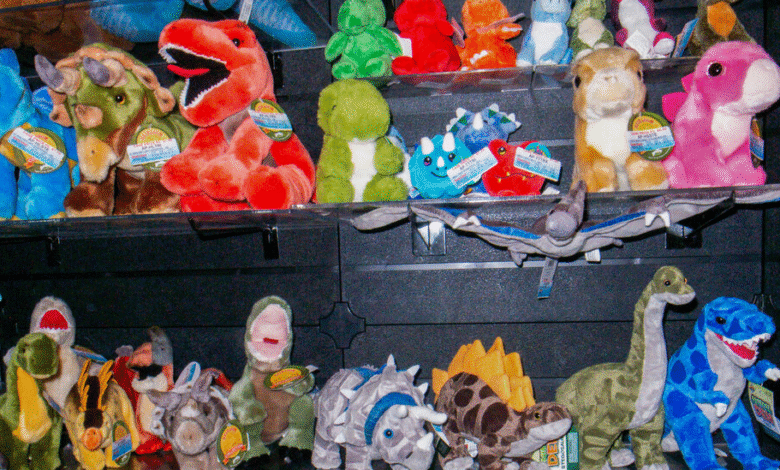Trump Tariffs on Toys: Fewer Dolls for U.S. Girls Ahead

The topic of Trump tariffs on toys has stirred significant debate regarding their impact on American consumers and the toy industry. President Donald Trump has argued that the presence of 145% tariffs on imports from China will ultimately favor the U.S., suggesting that American families can suffice with fewer toys, like dolls. Despite these claims, many critics argue that these tariffs are likely to lead to toy supply shortages, ultimately straining the US toy market. The tariffs impact on toys may force parents to spend more for fewer items, contradicting Trump’s assertion that children need fewer dolls. As the discourse unfolds, Trump’s comments on dolls have drawn criticism, highlighting a stark disconnect from the reality faced by families reliant on an affordable and diverse toy supply for their children.
The implications of tariffs imposed by the Trump administration on toys have raised crucial questions about their effects on American households and the broader economy. Known for his controversial remarks, Trump has suggested that children do not require an abundance of toys, particularly dolls, amid rising prices due to these tariffs. As the U.S. grapples with the consequences of tariffs aimed at curbing imports from China, many are concerned about the resulting toy supply challenges. These discussions about the tariffs’ influence on the availability of products reflect a broader anxiety regarding consumer spending power in the US toy market. Ultimately, as parents navigate the repercussions of these trade policies, the divide between political rhetoric and everyday experiences continues to widen.
The Impact of Trump Tariffs on the Toy Industry
Trump’s tariffs on toys, specifically a staggering 145% on imports from China, have ignited significant concerns within the toy industry. Retailers and manufacturers predict that these tariffs will lead to supply shortages, leaving toy shelves emptier this holiday season. The imposition of such high tariffs directly affects the pricing and availability of children’s toys, which are predominantly sourced from China. As imports become costlier, consumers are faced with not only higher prices but potentially fewer choices, significantly altering the landscape of the U.S. toy market.
Moreover, retailers are bracing for what this means for sales during peak seasons. As toys become more expensive, families may reduce their purchases, leading to decreased revenue for toy companies. Analysts fear that the anticipated supply shortages could result in a ‘doll deficit,’ where families are unable to find popular items for gifts. This potential failure in supply can have ripple effects across the market, impacting various sectors, from manufacturing to retail, thereby reshaping the entire toy industry’s dynamics.
Trump’s Comments on Dolls: A Disconnect from Reality?
During recent interviews, Trump controversially stated that a young girl does not need ’37 dolls’ and that fewer choices could actually be more beneficial. Such comments have initiated a backlash from critics who argue that they reflect a significant disconnect from the struggles of everyday families. For many parents, the prospect of paying higher prices for fewer toys is not simply an abstract concern—it is a matter impacting their household budgets. This ongoing narrative, backed by Trump’s remarks, fuels the perception that he is out of touch with the realities faced by working-class families.
Critics have pointed out that such statements prioritize a broader economic strategy over the immediate needs of families who find joy and comfort in gifting toys to their children. The suggestion that children can simply make do with fewer dolls does not acknowledge the emotional value associated with childhood toys, which can symbolize companionship and joy. This perspective on personalizing children’s needs could diminish the significance that toys hold in a child’s upbringing, adding further tension to the ongoing discourse surrounding Trump’s tariffs on toys.
How Tariffs Could Lead to Toy Supply Shortages
The connection between Trump’s tariffs and potential toy supply shortages raises alarms throughout the retail sector. As tariffs increase the cost of importing toys from manufacturers, companies might limit their stock to manage profit margins, leading to inadequate inventory during high-demand periods like the holiday season. Analysts predict that parents might encounter empty shelves or forced to opt for less desired products, resulting in a frustrating shopping experience. This forecast showcases the tangible consequences of trade policy decisions falling heavily on consumers.
Additionally, companies that produce toys domestically may not be able to scale up operations quickly enough to fill in the gaps created by these tariffs. This challenge is particularly pronounced given that many toy companies have historically relied on Chinese manufacturing to take advantage of lower production costs. Therefore, with increased tariffs, many are left scrambling to balance cost-efficiency with consumer demand. Ultimately, the tariffs threaten to create a marketplace where toy availability becomes increasingly uncertain, impacting the holiday shopping experience.
China Tariff Consequences: What It Means for U.S. Consumers
The consequences of Trump’s tariffs on China reverberate beyond trade statistics; they pose real challenges to U.S. consumers. As Trump suggests that China will suffer more from the trade war, families in the U.S. will likely bear the brunt of increased costs linked to imported toys. Families accustomed to affordable pricing now face potential price hikes on staple goods like dolls and action figures. Such economic pressure indicates an imminent shift in spending behavior as households are forced to reassess their holiday budgets.
Additionally, these tariffs could push consumers to seek alternatives, like buying locally made toys that may have higher production costs. However, this does not necessarily equate to better availability or variety, as domestic toy options can be limited. As consumers navigate the ramifications of these tariffs, the resulting changes in purchasing patterns could disrupt long-established trends in the U.S. toy market, highlighting the broader impacts of tariffs beyond immediate economics.
The U.S. Toy Market: Shifting Dynamics Due to Tariffs
The U.S. toy market, once dominated by a rich variety of choices and affordable pricing, now faces unprecedented challenges thanks to Trump’s tariffs. As toys from China become more costly, and supply chains face disruptions, the overall dynamics within the toy market are shifting. Companies are re-evaluating their sourcing strategies, with many considering regional manufacturing or shifts to different supply chains, possibly leading to increased production costs.
This shift presents both challenges and opportunities for U.S. manufacturers, who may receive a boost from an increased consumer preference for domestic products. However, the cost implications could deter some families from purchasing new toys. As shelves grow emptier and prices rise, the future of the U.S. toy market hangs in a precarious balance, reflecting the ongoing complexities of international trade policies in the wake of Trump’s administration.
Democratic Backlash on Tariff Policies
Trump’s tariff policies have not only ignited debate among economists but have drawn sharp criticism from Democratic lawmakers who argue the plans are detrimental to working-class families. The backlash paints a picture of a leader disconnected from the realities many Americans face when navigating holiday shopping amid rising prices and fewer options. By expressing that children can happily do without numerous dolls, critics suggest Trump fails to understand the emotional and financial struggles of parents trying to provide for their children.
Progressive figures within the Democratic Party have also emphasized that Trump’s comments suggest a lack of empathy towards working-class families who are just trying to make ends meet. Senator Bernie Sanders’ rebuke highlights a fundamental critique of the Trump administration’s approach to tariffs, viewing them as an additional burden on families rather than a means to foster economic growth. This narrative continues to resonate with constituents, shaping the conversation around trade policies and their implications for the average American.
Consumer Reactions to Increased Toy Pricing
As tariffs drastically increase the costs of toys, consumer reactions are shaping a new dynamic within the market. Many families are expressing concern over impending price surges as they prepare for the holiday season, grappling with the realization that their gift lists may necessitate cuts due to higher prices. The sentiment among parents is that each dollar counts, especially when juggling multiple holiday expenses. The prospect of enduring short supplies drives home the seriousness of these tariffs’ impact on everyday shopping experiences.
Additionally, social media has become a platform for parents to voice their concerns and frustrations regarding the potential unavailability of toys amidst these trade policies. While some families contemplate postponing purchases or settling for fewer items, others are exploring alternative sources, potentially jeopardizing established shopping habits. This shift draws attention to how American families are adjusting to a new normal influenced by tariffs, encapsulating the sentiment that less truly may not mean more.
Prospects for Future Legislation on Tariffs
Looking ahead, the prospect of future legislation regarding tariffs is drawing scrutiny as policymakers and citizens alike analyze their implications. With increasing voices from both sides of the political aisle, there may be potential for revising current tariff rates to alleviate the burden on U.S. consumers. Many advocates are calling for a reconsideration of these policies to ensure that essential goods, particularly toys for children, remain accessible to families during peak purchasing seasons.
Moreover, the economic ramifications of ongoing tariffs can spark significant discussion during election cycles, pushing candidates to address how their policies would reshape the landscape for American families. As Americans engage with their representatives on this pressing issue, the outcome may not only impact future trade relations with China but set a precedent for how toy pricing and supply chain management are approached moving forward.
Understanding the Emotional Value of Toys
In discussions about toys, especially in light of Trump’s tariffs, it’s essential to recognize the deeper emotional significance these items hold for children and families. Toys are not merely playthings; they are instruments of imagination, learning, and emotional development. For many children, dolls represent companionship and nurture; reducing the variety available impacts more than just consumer choice—it alters the important fabric of childhood experiences.
Parents often aim to provide toys that foster creativity and connection, and with the impending supply shortages due to tariffs, the emotional repercussions of fewer dolls hit home. A child’s enjoyment often lies in the abundance of choices, and the limited availability caused by tariffs could lead to disappointment and frustration, affecting overall joyous moments in family gatherings or celebrations. Ultimately, understanding the emotional value tied to these items underlines the tangible effects of trade policies on American family life.
Frequently Asked Questions
How are Trump tariffs on toys affecting the US toy market?
Trump’s tariffs on toys, particularly the 145% tariffs on imports from China, are causing significant price increases and potential supply shortages in the US toy market. This situation may lead to higher costs for consumers and fewer choices available on store shelves.
What are the consequences of China tariffs on toys for American families?
The consequences of Trump’s China tariffs on toys could mean higher toy prices for American families and possibly fewer options available for purchase. Critics argue that the tariffs disproportionately affect working-class families who struggle to afford basic necessities, including toys for their children.
What comments did Trump make regarding dolls and supply shortages due to tariffs?
Trump downplayed the impact of tariffs by suggesting that American girls do not need an excessive number of dolls. He stated that having fewer dolls available due to tariffs might actually benefit children, implying that they can be happy with fewer, albeit more expensive, toys.
How might Trump’s tariffs impact toy supply shortages in the US?
Trump’s tariffs could lead to increased costs for toy manufacturers, which might result in supply shortages as companies may be unable to absorb these costs. This could cause fewer toys to be available in stores, leading to empty shelves during peak seasons.
Why are Trump’s tariffs on imported toys controversial?
Trump’s tariffs on imported toys are controversial because they are seen as disconnecting him from the realities faced by American families. Critics, including Democratic lawmakers, argue that these tariffs exacerbate economic burdens, particularly impacting families trying to buy gifts for their children.
| Key Point | Details |
|---|---|
| Trump’s Perspective | Trump believes girls can be happy with fewer dolls, stating they don’t need excessive toys. |
| Tariff Impact | The tariffs, particularly a 145% rate on imports from China, could lead to supply shortages and higher prices. |
| Criticism from Opponents | Democratic lawmakers criticize Trump for being out of touch with the struggles of working-class families affected by these tariffs. |
| Public Reaction | Republican strategist Karl Rove likened Trump’s comments to being reminiscent of ‘Mr. Scrooge’. |
Summary
Trump tariffs on toys could significantly alter the landscape for American consumers, as they may lead to fewer options and increased prices. Trump’s remarks reflect a belief that less is more when it comes to the toys available for children, yet these statements have drawn considerable backlash, suggesting a disconnect from the realities faced by many families. As the debate continues, the broader implications for toy availability and affordability remain a pressing concern.



